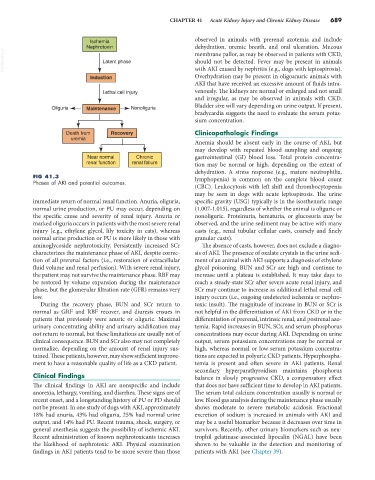Page 717 - Small Animal Internal Medicine, 6th Edition
P. 717
CHAPTER 41 Acute Kidney Injury and Chronic Kidney Disease 689
Ischemia observed in animals with prerenal azotemia and include
Ischemia
Nephrotoxin dehydration, uremic breath, and oral ulceration. Mucous
Nephrotoxin
VetBooks.ir Latent phase membrane pallor, as may be observed in patients with CKD,
should not be detected. Fever may be present in animals
with AKI caused by nephritis (e.g., dogs with leptospirosis).
Induction
Induction Overhydration may be present in oligoanuric animals with
AKI that have received an excessive amount of fluids intra-
Lethal cell injury venously. The kidneys are normal or enlarged and not small
and irregular, as may be observed in animals with CKD.
Oliguria Maintenance Nonoliguria Bladder size will vary depending on urine output. If present,
Maintenance
bradycardia suggests the need to evaluate the serum potas-
sium concentration.
Death from
Death from Recovery Clinicopathologic Findings
Recovery
uremia
uremia
Anemia should be absent early in the course of AKI, but
may develop with repeated blood sampling and ongoing
Near normal Chronic gastrointestinal (GI) blood loss. Total protein concentra-
Near normal
Chronic
renal failure
renal function renal failure tion may be normal or high, depending on the extent of
renal function
dehydration. A stress response (e.g., mature neutrophilia,
FIG 41.3 lymphopenia) is common on the complete blood count
Phases of AKI and potential outcomes.
(CBC). Leukocytosis with left shift and thrombocytopenia
may be seen in dogs with acute leptospirosis. The urine
immediate return of normal renal function. Anuria, oliguria, specific gravity (USG) typically is in the isosthenuric range
normal urine production, or PU may occur, depending on (1.007-1.015), regardless of whether the animal is oliguric or
the specific cause and severity of renal injury. Anuria or nonoliguric. Proteinuria, hematuria, or glucosuria may be
marked oliguria occurs in patients with the most severe renal observed, and the urine sediment may be active with many
injury (e.g., ethylene glycol, lily toxicity in cats), whereas casts (e.g., renal tubular cellular casts, coarsely and finely
normal urine production or PU is more likely in those with granular casts).
aminoglycoside nephrotoxicity. Persistently increased SCr The absence of casts, however, does not exclude a diagno-
characterizes the maintenance phase of AKI, despite correc- sis of AKI. The presence of oxalate crystals in the urine sedi-
tion of all prerenal factors (i.e., restoration of extracellular ment of an animal with AKI supports a diagnosis of ethylene
fluid volume and renal perfusion). With severe renal injury, glycol poisoning. BUN and SCr are high and continue to
the patient may not survive the maintenance phase. RBF may increase until a plateau is established. It may take days to
be restored by volume expansion during the maintenance reach a steady-state SCr after severe acute renal injury, and
phase, but the glomerular filtration rate (GFR) remains very SCr may continue to increase as additional lethal renal cell
low. injury occurs (i.e., ongoing undetected ischemia or nephro-
During the recovery phase, BUN and SCr return to toxic insult). The magnitude of increase in BUN or SCr is
normal as GRF and RBF recover, and diuresis ensues in not helpful in the differentiation of AKI from CKD or in the
patients that previously were anuric or oliguric. Maximal differentiation of prerenal, intrinsic renal, and postrenal azo-
urinary concentrating ability and urinary acidification may temia. Rapid increases in BUN, SCr, and serum phosphorus
not return to normal, but these limitations are usually not of concentrations may occur during AKI. Depending on urine
clinical consequence. BUN and SCr also may not completely output, serum potassium concentrations may be normal or
normalize, depending on the amount of renal injury sus- high, whereas normal or low serum potassium concentra-
tained. These patients, however, may show sufficient improve- tions are expected in polyuric CKD patients. Hyperphospha-
ment to have a reasonable quality of life as a CKD patient. temia is present and often severe in AKI patients. Renal
secondary hyperparathyroidism maintains phosphorus
Clinical Findings balance in slowly progressive CKD, a compensatory effect
The clinical findings in AKI are nonspecific and include that does not have sufficient time to develop in AKI patients.
anorexia, lethargy, vomiting, and diarrhea. These signs are of The serum total calcium concentration usually is normal or
recent onset, and a longstanding history of PU or PD should low. Blood gas analysis during the maintenance phase usually
not be present. In one study of dogs with AKI, approximately shows moderate to severe metabolic acidosis. Fractional
18% had anuria, 43% had oliguria, 25% had normal urine excretion of sodium is increased in animals with AKI and
output, and 14% had PU. Recent trauma, shock, surgery, or may be a useful biomarker because it decreases over time in
general anesthesia suggests the possibility of ischemic AKI. survivors. Recently, other urinary biomarkers such as neu-
Recent administration of known nephrotoxicants increases trophil gelatinase-associated lipocalin (NGAL) have been
the likelihood of nephrotoxic AKI. Physical examination shown to be valuable in the detection and monitoring of
findings in AKI patients tend to be more severe than those patients with AKI (see Chapter 39).

